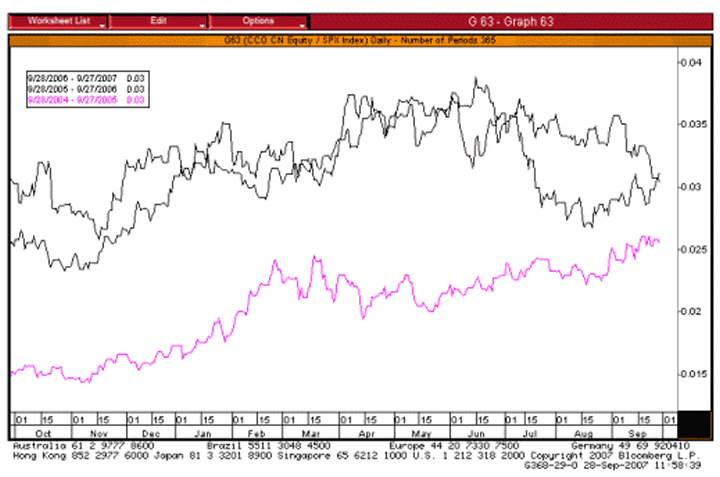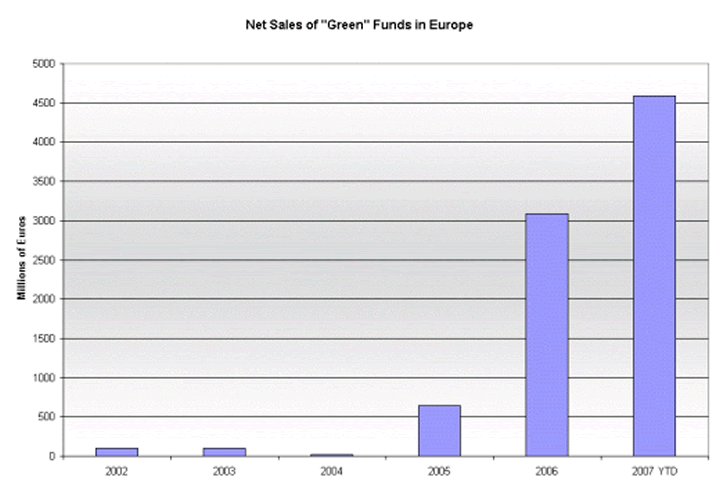Final Quarter Energy Trends for Uranium and Green Energy
Commodities / Energy Resources Sep 30, 2007 - 02:46 AM GMTBy: Elliot_H_Gue
 The final quarter of the year is always a crucial period for the energy markets. The quarter marks both the beginning of the winter heating season and a time when refiners look to rebuild their crude oil inventories. Often, trends that emerge during the quarter carry through into the new year.
The final quarter of the year is always a crucial period for the energy markets. The quarter marks both the beginning of the winter heating season and a time when refiners look to rebuild their crude oil inventories. Often, trends that emerge during the quarter carry through into the new year.
With crude oil prices hovering above $80 per barrel and natural gas recovering from its midsummer lows, the fourth quarter of 2007 promises to be even more pivotal for the energy patch than normal. In this week's issue, let's take a look at two trends I'll be watching carefully as we head into the final weeks of 2007.
Nuclear Power/Uranium
The fourth quarter of the year is a great time to look for a strong move higher in uranium mining stocks. There appears to be a strong seasonal tendency for uranium miners to bottom out sometime between the end of August and late October and rally through into 2008. Check out the chart below for a closer look.

Source: Bloomberg
To create this chart, I simply divided the price of Cameco by the S&P 500. Therefore, when these lines are rising, Cameco is outperforming the S&P 500 and vice versa. I used Cameco not because it's my favorite miner--it certainly isn't--but because it's the biggest pure-play uranium miner and is often considered a benchmark for the rest of the industry.
Note that I've plotted three lines on this chart, representing three different years: 2005, 2006 and 2007. While the lines aren't exactly the same, you can clearly see that all three rise from late October through at least early February. That means that Cameco has a strong tendency to outperform during this time frame; that's even more significant when you consider that the fourth quarter is seasonally a positive one for the market in general.
Cameco actually outperforms a rising market during this time of the year. While this chart shows only the past few years, I did look back further in time and the same basic pattern seems to hold.
I'm not normally a big fan of pure seasonal arguments for buying stocks. But, this tendency does make some fundamental sense. After all, the fourth quarter does bring the onset of the winter heating season in the Northern Hemisphere, a time of rising demand for electricity and nuclear power.
In addition, volume in the spot market for uranium tends to decline during the summer months. This spot market is never particularly liquid but during the summer months, volume all but fades away. As spot market activity picks up again in the fall, that refocuses attention on the uranium markets.
This year, the ratio appears to have bottomed in late August, somewhat earlier than normal. Nonetheless, I believe uranium mining firms are now in the first few weeks of a seasonal rally that will carry into 2008.
In addition to this seasonal effect, investors shouldn't ignore NRG Energy's recent decision to apply for a new nuclear plant construction permit. This is the first construction permit application to be filed in the US for nearly three decades. While this single plant won't mean much for global uranium demand, it's a sea-change when it comes to sentiment. Remember that many investors, no matter where they're based, remain stubbornly US-centric so a new nuclear plant in the US would serve to underline the fact that a nuclear renaissance is underway.
The NRG plant is located on the site of an existing facility, helping to quell opposition from local residents. In addition, NRG looks likely to get significant technical assistance from Japan, an experienced player in the nuclear industry. Japanese firms may even look to take a direct financial stake in the project, helping to ease the large up-front capital costs required to build a new plant.
The status of this application will be widely watched by the rest of the industry. It's likely to become a sort of roadmap for other would-be nuclear plant builders in the US.
Alternative Energy
Alternative energy stocks are hot. Earlier this week, I took a closer look at the performance of all of the recommendations in The Energy Strategist --a detailed monthly review I undertake. Of all the stocks, my alternative energy plays were the best-performing; on average, my alternative energy picks are up around 20 percent since the end of August.
I suspect the cause of that run-up is a huge wall of cash that's being invested in environmentally friendly “green” funds. I saw a version of the chart below in Monday's issue of the Financial Times .

Source: Financial Times
This chart shows the total amount invested in funds that focus on environmentally friendly green investments; a big portion of that would be renewable and alternative energy technology firms. The data covers only the European market for such funds. Through the end of July alone, green funds attracted more than 4.5 billion euros in investments ($6.5 billion). That's 50 percent more than the entire investment in 2006 and 2007 is barely halfway over yet. Amazingly, that investment accounted for 15 percent of all monies invested in equity funds in Europe so far this year.
In addition, myriad new indexes have been created during the past twelve months to track the profitability of such investment themes as global warming, alternative energies and ecologically sustainable investing. The latest is a series of indexes created by HSBC to track themes such as electricity generators with low emissions, energy efficiency companies such as insulation manufacturers, and pollution control technology firms.
Up until the last year or two, alternative energy firms have been considered a sort of backwater of the energy business. These companies are still tiny when compared to the big integrated oil companies or the big services names. As you can imagine, all that cash and investment piling into a relatively short list of stocks is pushing prices higher.
Of course, government subsidies and investments are also powering growth for the industry. Many investors assume such subsidies are exclusively a developed-world phenomenon, but that's just not the case. China is now the world's sixth largest wind power producer and has plans to become No. 1 in the next three to five years. The government there has a target to boost renewables (including hydropower) to 15 percent of the grid by 2020. A big part of that is offering assistance and tax breaks for wind and other alternative power technologies.
Whenever you hear of that degree of hype and excitement surrounding a single group of stocks, it's logical to ask if it's an unsustainable bubble for the group. And certainly, there are some elements of a bubble in place; valuations have been getting stretched for some companies in the alternative energy patch.
My view is that the alternative energy sector isn't yet generally in an outright bubble. Unlike tech stocks in the late '90s, valuations are supported in many cases by accelerating growth backed up by government largesse. Ironically, the alternative energy sector is less vulnerable to an economic slowdown than most sectors of the energy patch; the reason is that growth in the group is powered by government subsidies.
That said, making money in the group will increasingly be a matter of selectivity and stock-picking rather than throwing darts at an list of stocks involved in this market. There are still plenty of companies that aren't getting the attention they deserve despite strong leverage to alternative energy and environmental themes.
By Elliott H. Gue
The Energy Letter
© 2007 Elliott H. Gue
Elliott H. Gue is editor of The Energy Letter , a bi-weekly e-letter as well as editor of The Energy Strategist , a premium bi-weekly newsletter on the energy markets. Mr. Gue is also associate editor for Personal Finance , where he contributes his knowledge of the energy markets.
Mr. Gue has a Master's of Finance degree from the University of London and a Bachelor of Science degree in Economics and Management from the University of London , graduating in the top 3 percent of his class. Mr. Gue was the first American student to ever complete a full degree at that university.
Elliott H. Gue Archive |
© 2005-2022 http://www.MarketOracle.co.uk - The Market Oracle is a FREE Daily Financial Markets Analysis & Forecasting online publication.



